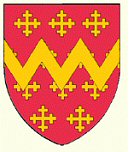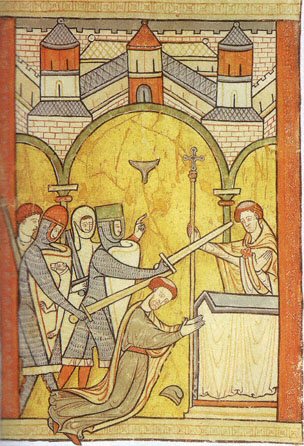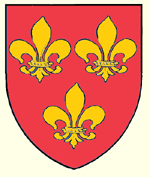 |
The Hissem-Montague Family  |
 |
The Hissem-Montague Family  |
The name means 'son of the bear.' The earliest members of this family are unknown, but it is assumed that a Hastings veteran nicknamed Ursa, "bear," founded the clan. The Family Arms: A bear sable, sometimes depicted as three bears on an argent field.
(2) Ursa (c1050)Urso, Ours. The progenitor of the family. He had, under the Conqueror, held Grittleston in Wiltshire, of the Abbey of Glastonbury.
(3) Richard Fitzurse (c1090)Ricardus filius Ursi. There may be an intervening generation, the genealogies disagree. He became possessed in the reign of Stephen of the manor of Willeton in Somersetshire, which descended to his son (?), Reginald. He also held Barham court in Kent and was tenant in chief in Northamptonshire. Specifically, he held Bulwick in Northamptonshire.
Richard married Matilda [Maude] de Boulers de Aubigny. She was born in about 1097, the daughter of Baldwin de Boulers [Bollers, Boullers, Bouliers], the Lord of Montgomery, and Sibyl de Falaise. Matilda had a sister, Hillaria, who died sine prole. I don't know if this is important, but I'll leave it here for now.
| Baldwin de Boulers
His surname is sometimes rendered Bollers, Bullers, Bulers, or Boullers. Baldwin was a younger son of Stephen, Baron of Boulers [Boelare], in Flanders, and a member of the First Crusade. The barony of Boelare was comprised of 16 villages southwest of Brussels. Alternately his father was Hamon De Aubigny, Lord Belers, of Derbyshire, England. Hamon's father was Nele de Aubigny, who was born in Aubigny, Normandy. Robert and Sampson Belers De Aubigney, born between 1146 and 1148 in Ketelby Belers were Baldwin's brothers. In this scenario the Boulers in the name appears to refer to a manor they held, i.e. "de" Ketelby Bellars. Baldwin held Montgomery, a motte and bailey castle, on the marches of Wales. This castle had originally been built by Earl Roger de Montgomery, Earl of Shrewsbury, and companion of the Conqueror. Upon the rebellion of his son, in favor of Duke Robert of Normandy, the castle was confiscated by Henry I and later granted it to Baldwin in free marriage with Sibyl de Falaise. "Free marriage" indicates that no service, or fee, was required as a condition of tenure. Today's Montgomery castle is a later construction. The old castle is now known as Hen Domen and is nothing more than an earthen eminence. The town today is known as Trefaldwyn, Welsh for "Baldwin's town." Baldwin married Sibyl de Falaise, who was either the neice, nepos, or the illegitimate daughter of Henry I and Isabella Corbet. Other sources show Sibyl's father as William Falaise, which is so much less exciting. One source claims the couple married in Falaise, Calvados, France in 1094. See the Mowbray family page for more about her descent. After Sibyl's death, Baldwin married Margaret de Limesi [Lymeseye]. Their children were Stephen, Almeric [I think], Galfridus, Margaret [d.s.p.] and Sibil, who married into the de Stanton family. Stephen, sometimes referred to as Baldwin's stepson, inherited the Honor and castle of Montgomery. Stephen was slain by Llywelyn ap Madog of Powys in 1152 [or 1162] and the lordship of Montgomery passed to Almeric de Boulers. Upon his death in 1176 it passed to Stephen's son, Robert de Bollers. Robert married, but had no surviving children. He died in 1203 and his wife, Hillaria, gave the King 300 marks and a palfrey not to be required to marry again. Robert's brother, Baldwin, then inherited. In 1207 a devastating raid by the Welsh killed Baldwin, who d.s.p. At this point the King took back the Honour of Montgomery. Baldwin's children with his first wife, Sibyl, were Maud, who married Richard Fitzurse, and Hillaria. |
Richard was a follower of King Stephen in his wars with the Empress Matilda. At the battle of Lincoln, in 1141, fighting against the Earls of Gloucester and Chester, he was captured, as was the King.
"Capitur etiam Ricardus filius Ursi qui in istibus dandis et recipiendiis clarus et gloriosus compariut." - from "Somerset Record Society"Richard died in about 1168. His children were,
She was born about 1119 in Northamptonshire, England and died after 21 May 1196. She married Richard II de Engayne of Laxton and Pytchley, Northamptonshire. Richard was born in about 1137 in Laxton, Northamptonshire, and died in 1177. He was the son of Viel de Engayne and a brother of Fulk de Lisures. This family is important for its land dealings with Roger Gernet, a relative through the Fitzurse daughters. Her other children, listed as the Great Grandchildren of Richard Fitzurse, are Joan (d' Engayne) Engaine, Sir Nicholas Engaine, Joyce d' Engaine, Johanna d' Engayne and Mary Dacre (Darcy). Margery later married Geoffrey le Breton.
(5) Richard III de Engayne (1167)The son of Margery Fitzurse and Richard II de Engaine. He married Sarah de Chesney, Lady Colne, and died on 23 April 1209.
(6) Sir Viel de Engayne (c1197)
 Of Laxton, Pytchley, Blatherwycke, & Bulwick, Northamptonshire; Great Gidding & Dillington, Huntingdon; White Notley & Colne Engaine, Essex; Hunsdon, Hertfordshire, England. He married Rohese [Montgomery]. He took up with Simon de Montfort in the Baron's Rebellion, "Who having also been with his Brother Richard, in Armes against King John, sped as he did, as to the seizure of his Lands: but in 1 Hen. 3.(those storms being over) had restitution of them again." The lands seized had been granted to William de Cauntelo, below.
Of Laxton, Pytchley, Blatherwycke, & Bulwick, Northamptonshire; Great Gidding & Dillington, Huntingdon; White Notley & Colne Engaine, Essex; Hunsdon, Hertfordshire, England. He married Rohese [Montgomery]. He took up with Simon de Montfort in the Baron's Rebellion, "Who having also been with his Brother Richard, in Armes against King John, sped as he did, as to the seizure of his Lands: but in 1 Hen. 3.(those storms being over) had restitution of them again." The lands seized had been granted to William de Cauntelo, below.
Roger Gernet jointly held an estate with Viel in Upminster, Essex, later called the Gaynes estate, inheriting via Richard FitzUrse's daughter Mabel, his mother. He was later bought out by his partner, Viel Engayne. There are also records showing Roger's claim to the Honor of Montgomery in Wales, a manor in Worle, Somerset, and another in Badmondisfield (aka Bansfield), Suffolk, though these were contested by other heirs of the FitzUrse family.
The Thomas Beckett Murder Baron. Reginald was the eldest son of Richard Fitzurse. He was born in about 1125 in Northamptonshire, England. On the death of his father in about 1168 he inherited the manor of Williton, Somersetshire, as well as the manor of Barham, Kent, and lands in Northamptonshire - from the "Dictionary of National Biography," Volume 22, referencing the Liber niger. He was one of the four knights [William de Tracy, Hugh de Morville, Richard le Breton [Brito] and Reginald Fitz-Urse] who were stirred up by the hasty words of Henry II to plot the death of the Archbishop of Canterbury, Thomas a Beckett, on 29 December 1170. They were excommunicated by the pope, and the king advised them to flee into Scotland. Note in the picture to the right, the knight with the red helmet has a bear on his shield. This is Reginald, who took the lead in the attack.
Baron. Reginald was the eldest son of Richard Fitzurse. He was born in about 1125 in Northamptonshire, England. On the death of his father in about 1168 he inherited the manor of Williton, Somersetshire, as well as the manor of Barham, Kent, and lands in Northamptonshire - from the "Dictionary of National Biography," Volume 22, referencing the Liber niger. He was one of the four knights [William de Tracy, Hugh de Morville, Richard le Breton [Brito] and Reginald Fitz-Urse] who were stirred up by the hasty words of Henry II to plot the death of the Archbishop of Canterbury, Thomas a Beckett, on 29 December 1170. They were excommunicated by the pope, and the king advised them to flee into Scotland. Note in the picture to the right, the knight with the red helmet has a bear on his shield. This is Reginald, who took the lead in the attack.
"All shunned them and even dogs refused to eat morsels of their meat. At last they were forced by hunger and misery to give themselves up to the King." Henry did not know what to do with them, for as murderers of a priest they were not amenable to lay jurisdiction, so he sent them to the Pope, who could inflict no heavier penalty than fasting and banishment to the Holy Land. Before he left Reginald Fitzurse gave half his manor of Williton to his brother and half to the Knights of St. John [the Hospitalers]. He and his companions are said to have performed their penance in the Black Mountain (various explanations of this name have been given; none are satisfactory; it was evidently intended to indicate some place, probably a religious house, near Jerusalem), to have died there, and to have been buried at Jerusalem before the door of the Templars' church. It was believed that all died within three years of the date of their crime, that is by 1173.
Hugh Morville of Yorkshire was witness to a grant by Reginald FitzUrse of a moiety of Williton and its house to his brother Robert and the other moiety to the Templars as alms for his soul - from the "Dictionary of National Biography."
Reginald apparently married Beatrice de Limesi [Limesey], the daugher of Geoffrey de Limesi of Devonshire. There is some confusion because some descents hold that Benedict Gernet's wife, Mabel, was a daughter of Reginald and Beatrice. I show her as a sister of Reginald. The de Limesi family, by the way, apparently returned to the continent when the French King seized Normandy, preferring their domains in France to those in England.
Reginald had only daughters,
(5) Unknown Female Fitzurse, who married into the FitzBaldwin family
(5) Matilda [Maud] Fitzurse, who married Robert de Curtenai
(5) Unknown Femail Fitzurse, who married Henry Fulford
In Copinger's Manors of Suffolk, Volume V, the article on the Manor of Badmondisfield Hall [aka Bansfield], Copinger writes: "Maud [de Aubigney], the daughter and heir of Baldwin and Sibil, married Richard Fitz Urse, and they were succeeded by their son and heir, Reginald Fitz Urse, who left a daughter and heir.
This next is from an online book, The Golden Falcon. I can't attest for its accuracy, but it is interesting. "Reginald left only daughters, one of whom was wife of a FitzBaldwin of Rhyd-y-gors, Pembrokshire to whose family she brought Montgomery Castle. This conflicts with the knowledge that Stephen de Bouler, the brother of Maud, was Lord of Montgomery after his father, Baldwin, and his two sons inherited in turn. To straighten this we'd have to assume that a daughter of Reginald daughter married a son of Stephen "FitzBaldwin" de Bouler, her cousin. According to Welsh genealogies, William fitzBaldwin's daughter married the son of Walter or William de Lacy who became lord of Rhyd-y-gors and Menorgain and took his surname of Gwyntwr or Winter from Castell Gwyn." Confusing, huh?
(5) Matilda [Maud] FitzurseShe married Robert de Curtenai. She inheritied the Gaynes estate and left a son.
(6) William de CurtenaiHe died without issue before 1242, leaving a widow, Ada. At that date Illaria Trusebut, widow of Robert de Bellers [Boulers], held it [Williton] in dower, and a partition was made of the estates of William de Curtenai between his heirs, William de Cantilupe and Vitalis Engaine.' The Gaynes estate was split between Viel Engayne and Roger Gernet, inheriting via Richard FitzUrse's daughters.
(5) Unknown Female FitzursePer "Landed Gentry of Great Britain and Ireland," Henry Fulford, of Fulford, married the daughter and heir of Fitzurse, of Williton, Somerset.
The Second Son & HeirSome make him out to be Reginald's son, vice brother, and others say that he was Reginald's kinsman. Others contend that there were two Roberts, one a brother who inherited his brother's estates and another, his kinsman, who inherited Barham. I will assume there was a single brother.
Robert was born circa 1130 in Bulwick, Northamptonshire, England. Soon after 1171 he received a grant of "a moiety of Williton" and its house from Reginald, as witnessed by Hugh Morville of Yorkshire. The other half was given, in penance, to the Knights of St. John. Some sources refer to this bequest as "the major portion" of Reginald's lands. As late as 1242 Robert's widow, Ida, still lived, holding Williton in dower. He also received the manor of Barham. Berham is the English of Fitzurse.
A chapel at Williton, named for St Peter, was founded by Robert Fitzurse, perhaps to expiate his brother's crime. The medieval chapel was dedicated to All Saints.
Robert apparently changed his name to de Barham, though whether this was in reaction to his brother's disgrace or simply per Norman practice of using locative names is unknown. Barham is a village in Kent, 6 miles southeast of Canterbury. The Fitzurse had been tenants of the Archbishop. The manor was held by Fitzurse descendents until the time of James I.
(5) Robert de Barham [Bereham]Of Kent and Sussex. He adopted the locative name of the estate of Barham. The question is, if Robert existed, why was the estate of his father divided between the families of Robert's sisters?
(6) Richard de Barham [Bereham]He may actually be a grandson of Robert vice a son given the dates of some of the offices he held. Historians in 1619 and again in 1633 claimed that all the Barhams in the areas of Kent and Sussex descended from this man. Richard 'the Sheriff' succeeded to his father's estate, residing in the ancestral home of the Barhams known as Sissinghurst Castle. He gave several terms of distinguished service to the Crown: Commissioner of the Peace in 1381, Commissioner of the Array in 1385, Sheriff of Kent in 1390-91, Commissioner of the Array in 1403, 1405 and 1407, Commissioner of Array for the defense of the Realm while the King is in Foreign parts for the recovery of the inheritance and rights of the Crown.
The Third SonThere is a great deal of confusion between Robert and Richard. They may be one and the same person. If he existed, Richard was born circa 1150.
(5) Warine Fitzurse de Bereham (circa 1175)The son of Richard Fitzurse, Warine held lands in Barham near Canterbury by Knight service as one of the military tenants of the Archbishop in 1210.
(6) Gilbert Fitzurse de Bereham (circa 1200)The son of Warin. He married Lucy de Ocholte. His children were Henry, Warin and Gilbert de Bereham. 26 November 1243: "Pardon to Gilbert de Bereham for the death of Richard de Tapinton whom he killed by misadventure with a lance in jousting; on condition that he make his peace with the relatives and stand is trial if anyone will proceed against him." He died sometime before 24 July 1255.
The Cantelo Family Connection She was born in about 1132 in Northamptonshire, England. She married a Cantelo, thus the lawsuit, below, over the Gayne estate brought by William de Cantelo [Cauntelo, Cantelou, Canilupe], Sheriff of Warwickshire and Leicester, a possible son of Maud's. Paget's Baronage mss. had the mother of William de Cantelupe (b.c.1170) as perhaps Maud, daughter of Reginald Fitz Urse, but then changed his mind and crossed it out. His arms were Gules three fleurs de lis or.
She was born in about 1132 in Northamptonshire, England. She married a Cantelo, thus the lawsuit, below, over the Gayne estate brought by William de Cantelo [Cauntelo, Cantelou, Canilupe], Sheriff of Warwickshire and Leicester, a possible son of Maud's. Paget's Baronage mss. had the mother of William de Cantelupe (b.c.1170) as perhaps Maud, daughter of Reginald Fitz Urse, but then changed his mind and crossed it out. His arms were Gules three fleurs de lis or.
By the way, William de Cantelo
"forsook the King and adhered to the Rebellious Barons [the Simon de Montfort Rebellion]; being one of those who called in Lewes [Louis] of France, with design to make him King. But in this Error he persisted not long; for within the compass of that year, coming off to the King, he had a Grant of all the Lands of Richard de Engaine, and Vitalis de Engaine his Son (great Actors in that Rebellion) and was made Governor of the strong Castle of Kenilworth in Warwickshire, being again Steward [s] of the King's Houshold."The Gernet Family Connection
The third Fitzurse daughter, she was born in about 1140. In about 1170, Mabel married Benet (Benedict) Gernet. He was born about 1136 in Lancashire, England. He died in 1205/1206. They had three known child: Roger, Benet and Joan Gernet. In some descents I've seen she's marked as Benet's 1st wife, but without a second wife being named.
(5) Roger Gernet (1173)The son and heir who contested the inheritance of the Fitzurse estates with the Engaines and Cauntelo's.